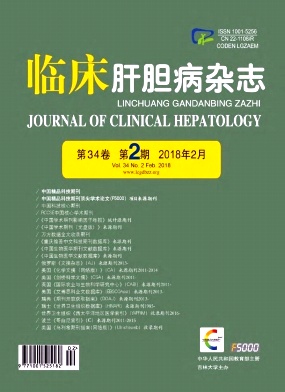|
[1]LAVANCHY D.The global burden of hepatitis C[J].Liver Int, 2009, 29 (Suppl 1) :74-81.
|
|
[2]MOHD HANAFIAH K, GROEGER J, FLAXMAN AD, et al.Global epidemiology of hepatitis C virus infection:new estimates of age-specific antibody to HCV seroprevalence[J].Hepatology, 2013, 57 (4) :1333-1342.
|
|
[3]GOMEZ EV, RODRIGUEZ YS, BERTOT LC, et al.The natural history of compensated HCV-related cirrhosis:a prospective long-term study[J].J Hepatol, 2013, 58 (3) :434-444.
|
|
[4]DASCHAKRABORTY S, AGGARWAL A, AGGARWAL R.Non-organ-specific autoantibodies in indian patients with chronic liver disease[J].Indian J Gastroenterol, 2012, 31 (5) :237-242.
|
|
[5]MARCONCINI ML, FAYAD L, SHIOZAWA MB, et al.Autoantibody profile in individuals with chronic hepatitis C[J].Rev Soc Bras Med Trop, 2013, 46 (2) :147-153.
|
|
[6]SANSONNO L, TUCCI FA, SANSONNO S, et al.B cells and HCV:an infection model of autoimmunity[J].Autoimmun Rev, 2009, 9 (2) :93-94.
|
|
[7]BAYRAKTAR Y, BAYRAKTAR M, GURAKAR A, et al.A comparison of the prevalence of autoantibodies in individuals with chronic hepatitis C and those with autoimmune hepatitis:the role of interferon in the development of autoimmune diseases[J].Hepatogastroenterology, 1997, 44 (14) :417-425.
|
|
[8]YEE LJ, KELLENHER P, GOLDIN RD, et al.Antinuclear antibodies (ANA) in chronic hepatitis C virus infection:correlates of positivity and clinical relevance[J].J Viral Hepat, 2004, 11 (5) :459-464.
|
|
[9]PENG YC, HAIEH SC, YANG DY, et al.Expression and clinical significance of antinuclear antibody in hepatitis C virus infection[J].J Clin Gastroenterol, 2001, 33 (5) :402-406.
|
|
[10]CASSANI F, CATALETA M, VALENTINI P, et al.Serum autoantibodies in chronic hepatitis C:comparison with autoimmune hepatitis and impact on the disease profile[J].Hepatology, 1997, 26 (3) :561-566.
|
|
[11]RIGOPOULOU EI, MYTILINAIOU M, ROMANIDOU O, et al.Autoimmune hepatitis-specific antibodies against soluble liver antigen and liver cytosol type 1 in patients with chronic viral hepatitis[J].J Autoimmune Dis, 2007, 4:2.
|
|
[12]NARCISO-SCHIAVON JL, SCHIAVON LDE L.Autoantibodies in chronic hepatitis C:a clinical perspective[J].World J Hepatol, 2015, 7 (8) :1074-1085.
|
|
[13]STROFFOLINI T, COLLOREDO G, GAETA GB, et al.Does an‘autoimmune’profile affect the clinical profile of chronic hepatitis C?An italian multicentre survey[J].J Viral Hepat, 2004, 11 (3) :257-262.
|
|
[14]Chinese Society of Hepatology and Chinese Society of Infectious Diseases Chinese, Medical Association.The guideline of prevention and treatment for hepatitis C:a 2015 update[J].J Clin Hepatol, 2015, 31 (12) :1961-1979. (in Chinese) 中华医学会肝病学分会, 中华医学会感染病学分会.丙型肝炎防治指南 (2015年更新版) [J].临床肝胆病杂志, 2015, 31 (12) :1961-1979.
|
|
[15]ISHAK K, BAPTISTA A, BIANCHI L, et al.Histological grading and staging of chronic hepatitis[J].J Hepatol, 1995, 22 (6) :696-699.
|
|
[16]BRUNT EM.Pathology of fatty liver disease[J].Mod Pathol, 2007, 20 (Suppl 1) :s40-s48.
|
|
[17]VERGANI D, ALVAREZ F, BIANCHI FB, et al.Liver autoimmune serology:a consensus statement from the committee for autoimmune serology of the international autoimmune hepatitis group[J].J Hepatol, 2004, 41 (4) :677-683.
|
|
[18]KUNIHOLM MH, GAO X, XUE X, et al.The relation of HLA genotype to hepatitis C viral load and markers of liver fibrosis in HIV-infected and HIV-uninfected women[J].J Infect Dis, 2011, 203 (12) :1807-1814.
|
|
[19]KERKAR N, CHOUHURI K, MA Y, et al.Cytochrome p4502d6 (193-212) :a new immunodominant epitope and target of virus/self cross-reactivity in liver kidney microsomal autoantibody type 1-positive liver disease[J].J Immunol, 2003, 170 (3) :1481-1489.
|
|
[20]SUTTI S, VIDALI M, MOMBELLO C, et al.Conformational anticytochrome P4502E1 (CYP2E1) auto-antibodies contribute to necro-inflammatory injury in chronic hepatitis C[J].J Viral Hepat, 2010, 17 (10) :685-690.
|
|
[21]MIZUOCHI T, ITO M, TAKAI K, et al.Differential susceptibility of peripheral blood CD5+and CD5-B cells to apoptosis in chronic hepatitis C patients[J].Biochem Biophys Res Commun, 2009, 389 (3) :512-515.
|
|
[22]CLAASSEN MA, DE KNEGT RJ, TILANUS HW, et al.Abundant numbers of regulatory T cells localize to the liver of chronic hepatitis C infected patients and limit the extent of fibrosis[J].J Hepatol, 2010, 52 (3) :315-321.
|
|
[23]WILLIAMS MJ, LAWSON A, NEAL KR, et al.Autoantibodies in chronic hepatitis C virus infection and their association with disease profile[J].J Viral Hepat, 2009, 16 (5) :325-331.
|
|
[24]LI WS, ZHAO JM, ZHOU GD, et al.The impact of autoantibodies on liver histology in hepatitis C[J/CD].Chin J Clinicians:Electronic Edition, 2011, 5 (20) :5969-5973. (in Chinese) 李文淑, 赵景民, 周光德, 等.HCV感染者自身抗体对肝脏损伤的影响[J/CD].中华临床医师杂志:电子版, 2011, 5 (20) :5969-5973.
|
|
[25]ROSKAMS TA, THEISE ND, BALABAUD C, et al.Nomenclature of the finer branches of the biliary tree:canals, ductules, and ductular reactions in human livers[J].Hepatology, 2004, 39 (6) :1739-1745.
|
|
[26]GOUW AS, CLOUSTON AD, THEISE ND.Ductular reactions in human liver:diversity at the interface[J].Hepatology, 2011, 54 (5) :1853-1863.
|
|
[27]AZMAIPARASHVILI E, BERISHVILI E, KAKABADZE Z, et al.Ductular reaction at the early terms of common bile duct ligation in the rats[J].Acta Biol Hung, 2012, 63 (3) :321-332.
|
|
[28]AFSARI A, LEE E, SHOKRANI B, et al.Clinical and pathological risk factors associated with liver fibrosis and steatosis in african-americans with chronic hepatitis C[J].Dig Dis Sci, 2017, 62 (8) :2159-2165.
|
|
[29]KAROUI S, TAIEB JOMI M, BELLIL K, et al.Steatosis in chronic viral hepatitis C:frequency, risk factors and relationship with fibrosis[J].Tunis Med, 2008, 86 (7) :670-675.
|







 DownLoad:
DownLoad: